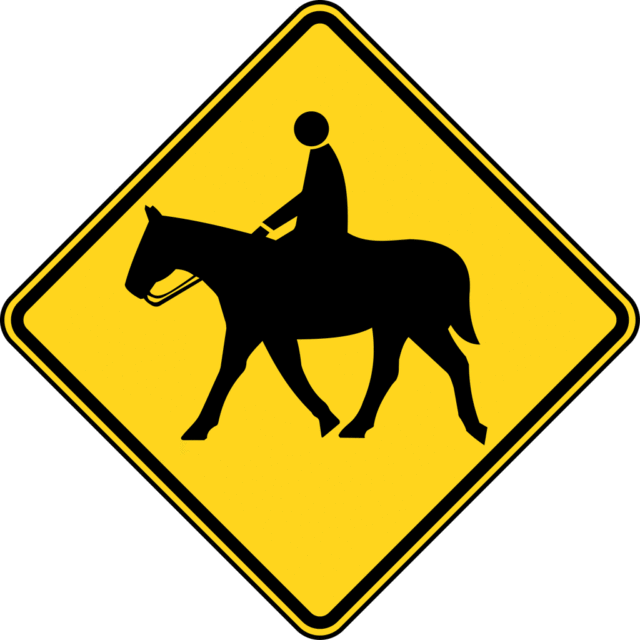In which there's a safety quiz to share with rider AND non-rider friends
STAY SAFE AROUND HORSES
(for riders and non-riders)
1. RIDER: You see lots of cars with bike racks parked at the trailhead. Do you:
a. Cuss, grumble, and go to a different trailhead
b. Put bear-bells on your horse to alert other trail users to
your presence
c. Put nasty notes on car windshields
d. Pull on your hi-viz vest
2. NON-RIDER with a dog: You see horse trailers parked at the trailhead, and you see hoof prints on the trail as you walk. Do you:
a. Keep your dog beside you as you walk, either on- or off-leash
b. Put bear-bells on your dog
c. Keep your dog on a leash
d. Holler “he’s friendly!” when he bounds up barking at horses
you meet
3. RIDER: You see a
person on the trail walking a dog on a leash.
Do you:
a. Yell at the person “You have to go away! I am afraid of dogs!”
b. Continue walking forward towards the person and the dog
c. Reverse course to avoid walking towards the person and the
dog
d. Speed up and run over the person with the dog
5. RIDER: You are riding your horse on a road, and see a large, loud vehicle approaching at high speed. Do you:
a. Move your horse to the shoulder as quickly as possible and turn to face the vehicle.
b. Signal to the vehicle with your hands to "slow down"
c. Stand your ground in the middle of the traffic lane
d. Hop off your horse and stand calmly beside him while the vehicle goes past
6. NON-RIDER: You are riding your bike or electric pedal-assist bike quietly through the woods, and see a horse and rider coming towards you. They don't seem to see you. Do you:
a. Call out a friendly "Hello!" so they will know you are there.
b. Quickly and quietly move into the bushes and stand silently so you don't disturb their ride
c. Hop off the bike and move to the side of the trail
d. Keep riding forward until the horse and rider see you
7. RIDER: You ride into the trailhead, and children there are riding bikes around, yelling and waving their arms in a way that might unnerve your horse. Do you:
a. Stay mounted and encourage your horse to stand still to face them
b. Yell at the kids to quit being idiots
c. Yell at the parents to control their brats
d. Hop off your horse and calm him before approaching anybody else
8 NON-RIDER: You are driving to work and running late. Ahead on the road you see a horse and rider. Do you:
a. Swing wide, into the other lane if possible
b. Honk your car horn or rev the engine so they will hear you coming
c. Drive past fast so the horse won't have time to misbehave
d. Drive past slowly so the horse will not be threatened
Answers:
1. RIDER: You see lots of cars with bike racks at the
trailhead.
(a) If you dislike sharing trails, going to another
trailhead is valid. However, please
consider adding “bike-safe” skills to your horse’s training.
(b) and (d) Making
yourself more discern-able to other trail users (including wildlife) is always
a good safety option.
(c) This isn't necessarily unsafe, but it's really rude. Please
don’t.
2. NON-RIDER with a
dog.
(a) and (c) Keeping
your dog beside you is always best.
Thanks for being polite!
(b) If you are on
more remote trails, a bear-bell will alert other trail users that your dog is
there. Many horses will recognize a “belled”
dog as a non-threat. However, if your
dog tends to bark and chase, the bell isn’t enough to maintain safety around
horses.
(d) Your dog may be
the sweetest, friendliest dog in the world, but many horses will perceive an
animal running towards them as a threat, and may respond by bucking,
kicking, or running away. None of these
actions is safe for the rider or your dog.
Please restrain your dog around horses.
3. RIDER: You see a
person walking a dog on a leash.
(a) and (c) If you (or your horse) fears dogs, by all means
communicate this to the dog walker.
However, they are not required to leave. Here’s a better choice: “I’m afraid of dogs, can you wait there a
moment so I can go past you safely?” If
there is not room to do this safely, consider reversing your own course to
avoid conflicts between trail users.
(b) If there is room
to pass safely and you are travelling faster than the person with the dog,
approach at a walk and call out to them to tell them your intentions.
(d) Running people over is unsafe and rude.
(b) Deafening yourself to your surroundings isn't safe behavior. Instead, try option (d) of using a single earbud so you can simultaneously boogie down and stay aware of noises nearby.


Comments
Post a Comment
To err is human. To be anonymous is not.